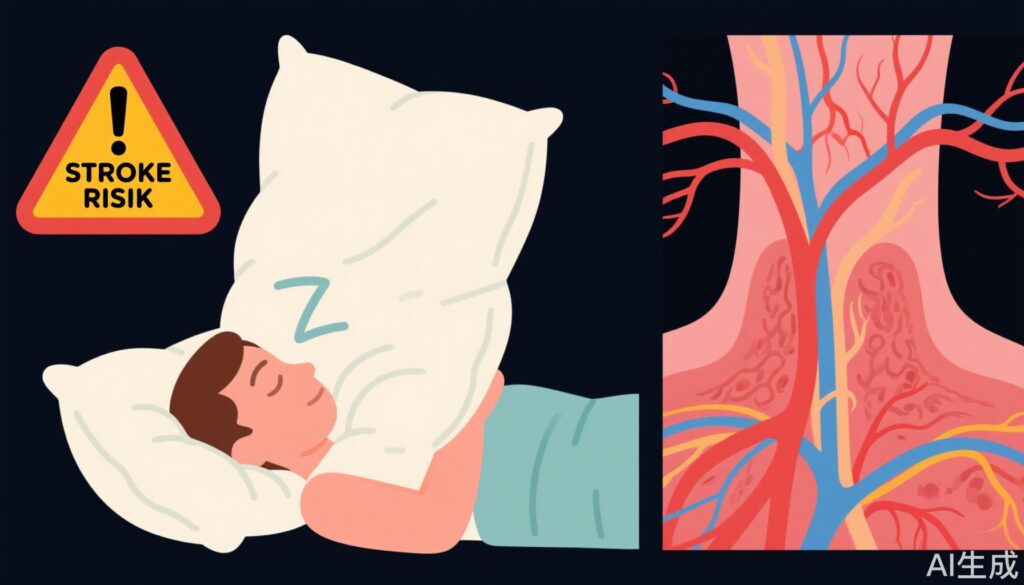Introduction: Can a High Pillow Trigger Stroke?
As living standards improve, people increasingly prioritize sleep quality. Pillows play an essential role in sleep comfort, with height and material being crucial factors. Recent research has alarmingly indicated that using pillows that are too high may increase the risk of stroke, specifically due to their impact on neck blood vessels.
High Pillows: An Unexpected Hidden Risk for Stroke?
Q1: Does using a pillow that’s too high really cause stroke?
A1: Yes. Studies show that excessively high pillows may trigger spontaneous vertebral artery dissection, which is one of the causes of ischemic stroke.
Q2: How do studies define a ‘high pillow’?
A2: A pillow over 12 centimeters in height is classified as a high pillow, while those exceeding 15 centimeters are considered extremely high pillows.
Q3: What is the incidence of spontaneous vertebral artery dissection among high pillow users?
A3: Among patients with spontaneous vertebral artery dissection, a significant number used pillows higher than 12 centimeters. In contrast, the control group showed a much lower usage of high pillows. The proportion of extremely high pillow users (over 15 cm) was notably higher in the patient group.
Q4: Why do high pillows increase stroke risk?
A4: High pillows increase neck flexion, which over prolonged periods can damage cervical blood vessels, causing dissection or thrombosis. If these clots or vessel wall tears travel to brain vessels, they can block blood flow and trigger stroke.
Q5: How to choose the right pillow?
A5:
– Moderate height: Choose a pillow height that aligns with or is slightly lower than shoulder width to maintain the neck’s natural curvature.
– Comfortable material: Use soft, breathable materials to avoid skin irritation and pressure.
– Appropriate shape: Select pillows designed to support the head and neck’s physiological curve.
Q6: What other factors increase stroke risk?
A6: Besides pillow height, hypertension, high cholesterol, diabetes, smoking, and physical inactivity are major contributors to stroke risk.
Q7: How to prevent stroke effectively?
A7:
– Manage blood pressure, cholesterol, and blood sugar levels.
– Maintain a healthy lifestyle: balanced diet, regular exercise, quit smoking, and limit alcohol.
– Regular health check-ups to detect and manage risk factors.
– Pay attention to sleep posture and pillow height to avoid excessive neck bending or twisting.
Is Sleeping Without a Pillow a Good Idea?
Sleeping without a pillow is generally not recommended. Long-term absence of pillow support can lead to multiple problems:
1. Impact on cervical spine health: The neck has a natural curve that pillows help support. Without a pillow, the neck may be left unsupported, potentially causing cervical spine issues like chronic neck pain or cervical spondylosis.
2. Effect on blood circulation: Sleeping without a pillow may cause the head to rest lower than the heart, increasing blood pooling in head vessels, potentially leading to dizziness, headaches, and poor sleep quality.
3. Reduced sleep quality: Pillows help maintain comfortable sleeping postures. Without them, poor sleep posture may cause muscle fatigue and insufficient rest.
4. Increased cardiac burden: A low head position relative to the chest can increase venous return, which might burden the heart, especially in individuals with heart or lung diseases.
5. Other risks: Lack of pillow support can cause muscle strain in the shoulders and neck, increase the risk of waking with a stiff neck, and reduce spinal stability.
Recommended Sleep Positions
Sleep position choice should consider personal comfort, health status, and preferences. Based on current research and clinical advice, here are some common sleep positions:
1. Side Sleeping
– Advantages: Right-side sleeping avoids pressure on the heart, reducing cardiac workload. It facilitates digestion since the stomach and intestines are positioned on the right side. Left-side sleeping benefits those with acid reflux, late pregnancy, or severe snoring.
– Recommendations: Place a pillow between the knees for comfort. Right-side sleeping is generally healthier, but left-side may be preferred for specific conditions.
2. Back Sleeping
– Advantages: Distributes body weight evenly, relaxes the lower back, and is good for people with neck or back pain.
– Recommendations: Use a pillow that maintains the neck’s natural curve (about 1.5 fists in height). Avoid placing arms across the chest to prevent restricted breathing.
3. Stomach Sleeping
– Suitable for: People with heavy physical labor or those with lower back muscle strain.
– Precautions: Avoid prolonged pressure on the face and eyes; may cause breathing difficulties, so not recommended for those with respiratory issues.
Summary
– Choose a sleep position based on comfort and health.
– Side sleeping, especially on the right, is often healthiest for heart and digestion.
– Back sleeping suits those with neck and back pain if pillow height is appropriate.
– Stomach sleeping may relieve some pain but can impair breathing and cause facial pressure.
– Experiment with positions to find what works best, and maintain good sleep habits and environment for optimal rest.
Conclusion
Excessively high pillows can pose a hidden risk for stroke by causing neck blood vessel damage. Selecting a pillow of appropriate height and material and adopting healthy sleep postures can help reduce this risk. Additionally, managing overall health and lifestyle factors remains crucial in stroke prevention. Avoid sleeping without a pillow to maintain spinal health and circulation. By understanding these factors and making informed choices, individuals can improve sleep quality and reduce the risk of serious conditions like stroke.



